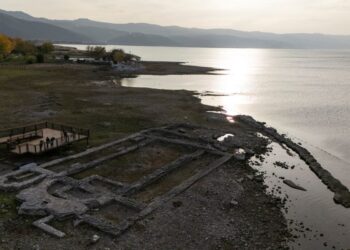IZNIK, Turkey — When Pope Leo XIV arrives to commemorate a seminal event in Christian history believed to have taken place here 1,700 years ago, he will pray at the once-sunken ruins of an ancient basilica that only recently emerged from Lake Iznik, a freshwater expanse whose very survival is now threatened.
The site of the church, a little over 50 miles southeast of Istanbul, was discovered still-submerged in 2014. But now it stands entirely on dry land, highlighting not only Iznik’s importance to early Christianity but also the brewing water crisis stalking this region.
Leo will find a community riven by resentment and loss, as residents here grapple with the lake’s gradual disappearance and grow anxious over their future, with some groups convinced that others in the region are taking more than their fair share of the water.
For years, the lake, one of Turkey’s largest, has been taxed by industrial sites that provide jobs but consume natural resources; a local economy bound up tightly with farming fueled by lake water; and the unfolding crisis of climate change — worldly forces that threaten the region and its people no matter which God they worship.
“When the water recedes, our belongings and possessions are lost. It means death,” said Vasfiye Durmus, 67, a local farmer who inherited a clutch of olive trees from her father.
Her patch of land, like many farms in this region that help power the country’s prodigious exports of olives and olive oil, was fed this year by lake water she purchased from the municipality, despite a policy from the state water agency barring its use for agriculture. The policy caused an uproar when it was announced earlier this year, after the lake’s depth had dipped below a critical threshold of 273 feet.
“There is no family that doesn’t use this water for their crops,” said Durmus in an interview, as she sat to take a brief break from the yearly olive harvest.
Mesut Aladag, a local Iznik official with Turkey’s State Hydraulic Works, the government agency that determines water usage, said in an interview that applying the policy was “impossible in this area,” but that his agency had reduced farmers’ rations of water this past summer.
The rule “was never enacted and it is a good thing that it was not. … These are laws that only protect the rich,” said Ahmet Egemen Aydin, an olive farmer who grew up in the area.
He blamed the crisis largely on factories, which he said were pumping out “unbelievably high amounts of water from the lake.” But there is also evidence that farming practices have changed in recent years, requiring more lake water. Aydin acknowledged that in the past decade, the amount of water his trees required had more than doubled because of a lack of rain.
Durmus also blamed a rise in kiwi farming, which she said had become more popular in the region in the past five years.
In response to questions, the Iznik municipality said the amount of lake water allocated legally for agricultural irrigation in the region is 55 million cubic meters (1.94 billion cubic feet) per year. According to the municipality’s figures, the lake receives about 312 million cubic meters (11 billion cubic feet) per year in rainfall, loses almost the same amount in evaporation, and faces a yearly water deficit of 65 million cubic meters (2.30 billion cubic feet).
In an emailed statement, the municipality said the decline in lake levels is mostly due to evaporation. It acknowledged that kiwis require more water “than many other crops,” but said that fruit’s cultivation in the Iznik valley is dwarfed by that of olives, with some 5,100 tons of kiwis and 45,000 tons of olives produced annually.
“The complete supply of agricultural water is vital to maintaining this production volume,” the statement said. “Therefore, our municipality will continue to support our farmers and ensure sustainable production.”
In Orhangazi, a city of 80,000 on Lake Iznik’s western shore, the local economy is powered by factories that pump out steel, fertilizer, starch, auto parts and other building blocks of the modern industrialized world. For the past three decades, Erol Cicek, an attorney, has devoted much of his time to stopping or slowing some of those very same industrial players, which he said often violate Turkish law and regulations.
Some industrial manufacturers in the area use local groundwater, according to court documents and scientists familiar with the lake. And Lake Iznik mainly feeds on local groundwater, said Reyhan Akcaalan Albay, an expert on lake ecology at Istanbul University.
Cicek and others fought a decade-long battle to block the U.S. agricultural giant Cargill from building a starch factory four miles from the lake — and while they won victories in Turkish courts, local officials refused to enforce the rulings and the factory went ahead, according to a 2018 ruling by the European Court of Human Rights. Cargill’s Turkish office did not respond to a request for comment.
“The main problem is implementation and carrying out court decisions,” Cicek said. “Turkey is not a rule-of-law state.” Turkish officials insist that the country is governed by the rule of law. The Justice Ministry did not respond to a request for comment.
In addition to groundwater, some industry relies directly on lake water to operate. On a recent day, an industrial site near the shore owned by Gemlik Gubre, a fertilizer producer, was sucking in lake water through a long, narrow pipe.
The company’s use of the water was authorized by government authorities and had decreased in recent years, said an employee who spoke on the condition of anonymity because he was not authorized to speak to a reporter. Gemlik Gubre did not respond to a request for comment.
A lack of publicly available government data on how much water is used by industry in the area makes it challenging to pinpoint the reasons behind the current crisis. Albay, who grew up in a farming family in Iznik, said that farming, climate change and the building of dams on feeder streams have all contributed to the lake shrinking, but do not fully explain its severity, which she suspects is due to industrial use.
Multiple government agencies and departments — including the Turkish agriculture and environment ministries, the state agency that manages water resources, and provincial and local governing bodies — did not respond to questions regarding the lake, including requests for data on water usage.
In a study last year, Turkish civil engineers found that Lake Iznik’s water level had dropped by nine inches and its surface area had decreased by about 300 acres each year since the basilica was discovered. They pointed to lower precipitation and higher temperatures in the region over the past decade.
Indeed, for residents, memories of drinking cold water from local springs have grown distant, and the piers that once jutted out from the shoreline and into the water now look out over mowed grass. At one of those piers, faded signs warn visitors in Turkish and English not to jump in the lake — a bitter joke, given the water’s edge is hundreds of feet away.
In 2014, when Turkish archaeologist Mustafa Sahin first spotted the church ruins via aerial photography, they were still submerged seven feet underwater and 160 feet from the shoreline. The basilica is believed to have been built in A.D. 380 at the site of the original church that hosted the Council of Nicaea. The basilica was later abandoned in the 13th century and then swallowed by rising lake waters.
Sahin, who is leading the excavation, denied the insinuations from some local farmers that archaeologists were draining the lake to speed up the excavation. In fact, the lake’s disappearance has made their job much harder, he said. As the lake has dried up, the soft, clay lake bed in which the ruins were nestled has hardened into a cement-like substance that makes excavation more difficult and increases the risk of damage to artifacts.
The disappearing lake also forced the Turkish Culture Ministry to scrap plans for an underwater museum that would have allowed visitors to peer into the depths. Tourists and pilgrims can now view the ruins from an outdoor platform, where Leo will hold his prayer.
When asked if Leo’s visit could raise awareness about the plight of the lake, Sahin opted to make a joke about the divine blessing that the Holy Father’s visit may bestow.
“The only way I can think of it being of help,” he said, “is if the pope’s presence brings more rain for us.”
The post At site of papal prayer in Turkey, a shrinking lake ‘means death’ appeared first on Washington Post.




